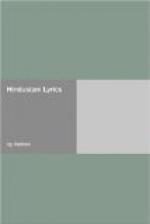MIR SOZ
MIR TAQI
Sauda
Taban
GLOSSARY
FOREWORD.
Of the many languages of India, Urdu (Hindustani) is the most widely known, especially in Upper India. Both as a written and a spoken language it has a reputation throughout Asia for elegance and expressiveness. Until the time of Muhammad Shah, Indian poetry was written in Persian. But that monarch, who mounted the throne of Delhi in 1719, greatly desired to make Urdu the vogue, and under his patronage and approval, Hatim, one of his ministers, and Wali of the Deccan, wrote Diwans in Urdu. This patronage of poets was continued by his successors, and exists indeed to the present day; and the cultivation of Urdu poetry has always been encouraged at the many Courts of India. Some of the Indian Rulers are themselves poets, and find their duty and pleasure in rewarding with gifts and pensions the literary men whose works they admire. The Court of Hyderabad has for long had a circle of poets: the late Nizam was himself eminent as a writer of verse. The Maharaja-Gaekwar of Baroda is a generous patron of literary men, and the present Rulers of lesser States such as Patiala, Nabha, Tonk, and Rampur, are deeply interested in the cultivation of poetry in their Dominions.
In the eighteenth and nineteenth centuries many towns in India had extensive and flourishing literary coteries, and it is from the poets of that period that this handful of verses is gathered. The Mushaira—a poetical concourse, wherein rival poets meet to try their skill in a tournament of verse—is still an institution in India. Delhi, Agra, Lucknow, Lahore, Cawnpore, Allahabad, Benares, Calcutta, and Hyderabad, have all been, and some still are, nests of singing birds. Of the extent of Urdu literature some idea may be gained from the fact that a History of it written about 1870 gives the names of some three thousand authors, and that Tazkiras or anthologies containing selections from many poets are very numerous.
The poetry is very varied and of great interest. It includes moral verses and counsels, sometimes in intermingled verse and prose; heroic poems telling the old tales of the loves of Khusru and Shirin, of Yusuf and Zuleika, of Majnun and Leila, and the romances of chivalry; elegies on the deaths of Hasan and Hussein, and of various monarchs; devotional poems in praise of Muhammad and the Imams; eulogies of the reigning Ruler or other patron or protector of the poor; satires upon men and institutions, sometimes upon Nature herself, specially upon such phenomena as heat, cold, inundations and pestilence; descriptive verse relating to the seasons and the months, the flowers and the trees. Above all there is a great wealth of love poetry, both secular and mystic, where, in impassioned ghazals or odes, the union of man with God is celebrated under various allegories, as the bee and the lotus, the nightingale and the rose, the moth and the flame.




